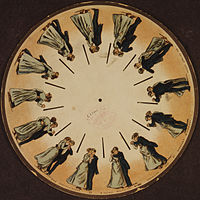Monday 31 May 2010
Early animation..
Zoetrope (180 AD; 1834)
The zoetrope is a device which creates the image of a moving picture. The earliest elementary zoetrope was created in China around 180 AD by the prolific inventor Ting Huan (丁緩). Made from translucent paper or mica panels, Huan hung the device over a lamp. The rising air turned vanes at the top from which hung the pictures painted on the panels would appear to move if the device is spun at the right speed.
The modern zoetrope was produced in 1834 by William George Horner. The device is essentially a cylinder with vertical slits around the sides. Around the inside edge of the cylinder there are a series of pictures on the opposite side to the slits. As the cylinder is spun, the user then looks through the slits to view the illusion of motion. The zoetrope is still being used in animation courses to illustrate early concepts of animation.
The magic lantern
The magic lantern is the predecessor of the modern day projector. It consisted of a translucent oil painting and a simple lamp. When put together in a darkened room, the image would appear larger on a flat surface. Athanasius Kircher spoke about this originating from China in the 16th century. Some slides for the lanterns contained parts that could be mechanically actuated to present limited movement on the screen.
Thaumatrope (1824)
A thaumatrope was a simple toy used in the Victorian era. A thaumatrope is a small circular disk or card with two different pictures on each side that was attached to a piece of string or a pair of strings running through the centre. When the string is twirled quickly between the fingers, the two pictures appear to combine into a single image. The thaumatrope demonstrates the Phi phenomenon, the brain's ability to persistently perceive an image. Its invention is variously credited to Charles Babbage, Peter Roget, or John Ayrton Paris, but Paris is known to have used one to illustrate the Phi phenomenon in 1824 to the Royal College of Physicians.
Phenakistoscope (1831)
The phenakistoscope was an early animation device, the predecessor of the zoetrope. It was invented in 1831 simultaneously by the Belgian Joseph Plateau and the Austrian Simon von Stampfer.
Flip book (1868)
The first flip book was patented in 1868 by a John Barnes Linnet. Flip books were yet another development that brought us closer to modern animation. Like the Zoetrope, the Flip Book creates the illusion of motion. A set of sequential pictures flipped at a high speed creates this effect. TheMutoscope (1894) is basically a flip book in a box with a crank handle to flip the pages.
Praxinoscope (1877)
The praxinoscope, invented by French scientist Charles-Émile Reynaud, was a more sophisticated version of the zoetrope. It used the same basic mechanism of a strip of images placed on the inside of a spinning cylinder, but instead of viewing it through slits, it was viewed in a series of small, stationary mirrors around the inside of the cylinder, so that the animation would stay in place, and provide a clearer image and better quality. Reynaud also developed a larger version of the praxinoscope that could be projected onto a screen, called the Théâtre Optique.
History of Animation, Wikipedia, Accessed on 31/5/10, http://en.wikipedia.org/wiki/History_of_animation
Sunday 23 May 2010
plasticine stitches..
Saturday 15 May 2010
Monday 26 April 2010
Sunday 25 April 2010
Animating..
Third Video- Red and blue plastercine, looking at 2 colours and transformation
Saturday 24 April 2010
Monday 19 April 2010
Saturday 17 April 2010
Saturday 10 April 2010
Aha
Monday 5 April 2010
Major Project
Friday 12 March 2010
Thursday 18 February 2010
Thursday 11 February 2010
Research for elective
Photographers : Digital Photography Elective
Jeff wall
Nancy Davenport architctral
Angela Strassheim
Alexander Apostol digitally manipulated built environment
Doug Aitken
Sam Taylor wood
Miriam Backstrom staging of life in her art
Mathew Buckingham
Roni Horn
Thomas Struth
Stephen Shore
AES+F group
Yto Barrada personal history landscape factorys
Armando Andrade Tudela
Bill Viola
Gillian Wearing
Tacita Dean
Douglas Gordon
Valerie Belin
Walead Beshty
Frank Breuer
Olaf Breuning
Phill Collins portraits
Kelli Connell portraits of couples
Sharon Lockhart
Aernout Mik
Sharon Core
Gregory Crewdson staged film stills,Suburban home becomes cinematic.
Andreas Gursky
Gerhard Richter
Candida Hofer
Thomas Demand
Wolfgang Tilman
Jennifer Allora and Guillermo Calzadilla
Cao Fei
Sue De Beer
Alicia Frankovich
Marine Hugonnier
Laura Letinsky
Peter Fischli/David Weiss
Richard Wentworth
Felix Gonzalez-Torres
Jane and Louise Wilson
Richard Adams black and white roads American
Bernd and Hilla Becher
Lewis Baltz parking lots/b/w industrial and colour offices
Martin Parr
Boris Mikhailov figrative
William Eggleston
Philip-Lorca diCorcia figurative
Caroline Shepard
Paul Graham
Larry Clark
Rineke Dijkstra portraits
Pierre Huyghe
Gabriel Orozco
Nobuyoshi Araki
Mathew Barney
Shigeru Takato
Vanessa Beecroft
Sindey Sherman
Nikki s lee
Lyn Hershman
Sophie Calle
Nan Golden
Tracey Moffatt
Tierney Gearon
Helen van Meene
Loreta Lux digital
Miklos Gaal
AES & F
Ryo Ohwada
Idris Khan
Martina Sauter
Eva Lauterlein
Nick Knight
Daniel pflumm
Paola Pivi
Fiona Tan
Rut lees Lusenburg
Tony Oursler
Philippe Parreno
Jack Pierson
Miklos Gaal
Erwin Wurm
Mariko Mori
Pipilotti Rist
Tuesday 19 January 2010
E-Waste
Monday 18 January 2010
quite like the looking glass..


"The time it takes a driver to glance down at the instrument cluster is typically 0.777 seconds. It may not sound like long, but when traveling at 60 miles per hour, this equates to a distance of 20.8 metres travelled without the driver’s eyes being on the road ahead. Our head-up displays will enhance road safety by helping drivers keep their eyes and their attention where they belong – on the road." (http://lightblueoptics.com/products/light-speed/)




















